Habitat Quality Evolution and Multi-Scenario Simulation Based on Land Use Change in the Tacheng Region
Abstract
1. Introduction
2. Materials and Methods
2.1. Study Area
2.2. Data Sources
2.3. Method of Analysis
2.3.1. IM Model
2.3.2. InVEST Model
2.3.3. PLUS Model
2.3.4. Accuracy Validation
2.3.5. Scenario Settings
3. Results and Analysis
3.1. Spatiotemporal Pattern Analysis of Land Use Change
3.1.1. Land Use Change
3.1.2. Land Use Intensity
3.1.3. Land Use Expansion Driving Analysis
3.2. Multi-Scenario Land Use Simulation and Prediction
3.3. Habitat Quality Change Analysis
3.3.1. Spatiotemporal Evolution of Habitat Quality
3.3.2. Multi-Scenario Habitat Quality Simulation
4. Discussion
4.1. Factors of Land Use Change
4.2. Impact of Land Use Change on Habitat Quality
4.3. Challenges and Countermeasures for Future Habitat Quality
4.4. Limitations and Prospects
5. Conclusions
- (1)
- Land use in the Tacheng region is predominantly characterized by grassland and unutilized land, collectively accounting for over 85% of the total area. During 2003–2023, grassland and water areas experienced continuous contraction, whereas cultivated land and unutilized land expanded significantly. Intense bidirectional conversions between grassland and unutilized land and cultivated land constitute the most defining feature of land use change in Tacheng, with large-scale grassland-to-unutilized land conversion being particularly pronounced. After grassland degrades to unutilized land, surface vegetation cover loss reduces soil water retention capacity, exacerbating soil erosion in the Tacheng region and disrupting the topographic water redistribution function. Analysis of land use expansion drivers reveals NDVI as the core natural determinant for unutilized land expansion in arid regions, addressing previous overreliance on climatic and socioeconomic factors. IM model results indicate that water, construction land, and forestland exhibit minimal land use intensity transition areas, predominantly displaying inhibition characteristics. These patterns substantially diminish overall habitat quality in Tacheng, thereby impairing biodiversity and ecological equilibrium.
- (2)
- From 2003 to 2023, the overall habitat quality in the Tacheng region exhibited a significant declining trend. Spatially, the distribution pattern was characterized by “high in the west and low in the east, high in the north and low in the south,” while temporally, the area of high habitat quality regions continuously and substantially decreased, accompanied by a significant expansion of low and relatively low habitat quality regions. This degradation trend is directly linked to the continuous loss of grassland and water ecological land during the study period, as well as habitat destruction, fragmentation, and weakening of ecosystem functions resulting from the expansion of cultivated land, construction land, and unutilized land. The habitat quality deterioration in the Tacheng region primarily stems from the unidirectional conversion of grassland and water areas into cultivated land and unutilized land.
- (3)
- Under the NDS and CLPS, habitat quality will continue to deteriorate. Both scenarios will result in a further reduction of grassland and water areas in the Tacheng region by 2033, accompanied by sustained expansion of cultivated land and unutilized land, thereby intensifying the decline in habitat quality. The EPS serves as an effective approach to improve habitat quality. By limiting the expansion of cultivated land, controlling the growth of unutilized land, and enhancing the protection and restoration of ecological land, this scenario leads to an increase in grassland, water, and forest areas while curbing the expansion of unutilized land and cultivated land, resulting in a significant improvement in habitat quality. Furthermore, a “zoning management and control” strategy was proposed based on habitat quality grades across different regions of the Tacheng region, offering a new paradigm for balancing cultivated land protection and ecological restoration in the ecological barrier areas of Northwest China. The EPS represents the key to maintaining regional ecological security barrier functions and achieving sustainable development in the Tacheng region, with ecosystem service functions expected to improve. This validates the positive effects of proactive ecological intervention measures in reversing degradation trends.
Author Contributions
Funding
Institutional Review Board Statement
Informed Consent Statement
Data Availability Statement
Acknowledgments
Conflicts of Interest
Abbreviations
| IM | Intensity Map |
| GDP | Gross Domestic Product |
| NDS | Natural Development Scenario |
| EPS | Ecological Protection Scenario |
| CLPS | Cultivated Land Protection Scenario |
| NDVI | Normalized Difference Vegetation Index |
| PLUS | Patch-generating Land Use Simulation Model |
| LESA | Land Expansion Analysis Strategy |
| CARS | CA based on Adaptive Random patch Seeds |
| InVEST | Integrated Valuation of Ecosystem Services and Tradeoffs |
References
- Poniatowski, D.; Stuhldreher, G.; Löffler, F.; Fartmann, T. Patch occupancy of grassland specialists: Habitat quality matters more than habitat connectivity. Biol. Conserv. 2018, 225, 237–244. [Google Scholar] [CrossRef]
- Aguilar, R.; Cristóbal-Pérez, E.J.; Balvino-Olvera, F.J.; Aguilar-Aguilar, M.D.J.; Aguirre-Acosta, N.; Ashworth, L.; Lobo, J.A.; Martén-Rodríguez, S.; Fuchs, E.J.; Sanchez-Montoya, G.; et al. Habitat fragmentation reduces plant progeny quality: A global synthesis. Ecol. Lett. 2019, 22, 1163–1173. [Google Scholar] [CrossRef] [PubMed]
- Krauss, J.; Bommarco, R.; Guardiola, M.; Heikkinen, R.K.; Helm, A.; Kuussaari, M.; Lindborg, R.; Öckinger, E.; Pärtel, M.; Pino, J.; et al. Habitat fragmentation causes immediate and time-delayed biodiversity loss at different trophic levels. Ecol. Lett. 2010, 13, 597–605. [Google Scholar] [CrossRef]
- Miller, J.R.; Groom, M.; Hess, G.R.; Steelman, T.; Stokes, D.L.; Thompson, J.; Bowman, T.; Fricke, L.; King, B.; Marquardt, R. Biodiversity conservation in local planning. Conserv. Biol. 2009, 23, 53–63. [Google Scholar] [CrossRef] [PubMed]
- Fu, B.J.; Chen, L.D.; Ma, K.M. The effect of land use Chang on the regional environment in the Yangjuangou catchment in the loess plateau of China. Acta Geogr. Sin. 1999, 54, 241–246. [Google Scholar] [CrossRef]
- Costa, G.C.; Nogueira, C.; Machado, R.B.; Colli, G.R. Sampling bias and the use of ecological niche modeling in conservation planning: A field evaluation in a biodiversity hotspot. Biodivers. Conserv. 2010, 19, 883–899. [Google Scholar] [CrossRef]
- Sherouse, B.C.; Semmens, D.J.; Clement, J.M. An application of social values for ecosystem services (SolVES) to three national forests in Colorado and Wyoming. Ecol. Indic. 2014, 36, 68–79. [Google Scholar] [CrossRef]
- Steenderen, V.J.C.; Sutton, F.G. Climate covariate selection influences MaxEnt model predictions and predictive accuracy under current and future climates. Ecol. Model. 2024, 498, 110872. [Google Scholar] [CrossRef]
- Li, Y.; Xie, W.; Zhang, J.; Zhang, D. Spatiotemporal changes and driving factors of ecological environmental quality in the Yongding-Luan River Basin based on RSEI. Front. Environ. Sci. 2024, 12, 1494098. [Google Scholar] [CrossRef]
- Terrado, M.; Sabater, S.; Chaplin-Kramer, B.; Mandle, L.; Ziv, G.; Acuña, V. Model development for the assessment of terrestrial and aquatic habitat quality in conservation planning. Sci. Total. Environ. 2016, 540, 63–70. [Google Scholar] [CrossRef]
- Van Dessel, W.; Van Rompaey, A.; Szilassi, P. Sensitivity analysis of logistic regression parameterization for land use and land cover probability estimation. Int. J. Geogr. Inf. Sci. 2011, 25, 489–508. [Google Scholar] [CrossRef]
- Ma, S.; Wang, L.; Wang, H.; Zhang, X.; Jiang, J. Spatial heterogeneity of ecosystem services in response to landscape patterns under the Grain for Green Program: A case-study in Kaihua County, China. Land Degrad. Dev. 2022, 33, 1901–1916. [Google Scholar] [CrossRef]
- Li, C.; Zhao, J.; Thinh, N.X.; Xi, Y. Assessment of the Effects of Urban Expansion on Terrestrial Carbon Storage: A Case Study in Xuzhou City, China. Sustainability 2018, 10, 647. [Google Scholar] [CrossRef]
- Hailu, T.; Assefa, E.; Zeleke, T. Urban expansion induced land use changes and its effect on ecosystem services in Addis Ababa, Ethiopia. Front. Environ. Sci. 2024, 12, 1454556. [Google Scholar] [CrossRef]
- Gashaw, T.; Tulu, T.; Argaw, M.; Worqlul, A.W. Modeling the hydrological impacts of land use/land cover changes in the Andassa watershed, Blue Nile Basin, Ethiopia. Sci. Total. Environ. 2018, 619–620, 1394–1408. [Google Scholar] [CrossRef]
- Chaplin-Kramer, R.; Sharp, R.P.; Mandle, L.; Sim, S.; Johnson, J.; Butnar, I.; Milà i Canals, L.; Eichelberger, B.A.; Ramler, I.; Mueller, C.; et al. Spatial patterns of agricultural expansion determine impacts on biodiversity and carbon storage. Proc. Natl. Acad. Sci. USA 2015, 112, 7402–7407. [Google Scholar] [CrossRef]
- Liu, Y.Y.; Liu, X.Y.; Zhang, B. Spatial features analysis of water conservation function in the hilly areas of the Loess Plateau based on InVEST model. Acta Ecol. Sin. 2020, 40, 6161–6170. [Google Scholar] [CrossRef]
- Chen, Y.; Zhang, F.; Lin, J. Projecting Future Land Use Evolution and Its Effect on Spatiotemporal Patterns of Habitat Quality in China. Appl. Sci. 2025, 15, 1042. [Google Scholar] [CrossRef]
- Varga, O.G.; Pontius, R.G., Jr.; Singh, S.K.; Szabó, S. Intensity Analysis and the Figure of Merit’s components for assessment of a Cellular Automata—Markov simulation model. Ecol. Indic. 2019, 101, 933–942. [Google Scholar] [CrossRef]
- Aburas, M.M.; Ho, Y.M.; Ramli, M.F.; Ash’aAri, Z.H. Improving the capability of an integrated CA-Markov model to simulate spatio-temporal urban growth trends using an Analytical Hierarchy Process and Frequency Ratio. Int. J. Appl. Earth Obs. Geoinf. 2017, 59, 65–78. [Google Scholar] [CrossRef]
- Siabi, E.K.; Kabo-Bah, A.T.; Anornu, G.; Akpoti, K.; Mortey, E.M.; Incoom, A.B.M.; Yeboah, K.A. Future land use simulation modeling for sustainable urban development under the shared socioeconomic pathways in West African megacities: Insights from Greater Accra Region. J. Environ. Manag. 2025, 376, 124300. [Google Scholar] [CrossRef] [PubMed]
- Verburg, P.H.; Soepboer, W.; Veldkamp, A.; Limpiada, R.; Espaldon, V.; Mastura, S.S.A. Modeling the Spatial Dynamics of Regional Land Use: The CLUE-S Model. Environ. Manag. 2002, 30, 391–405. [Google Scholar] [CrossRef]
- Rong, Y.J.; Zhang, H.; Wang, Y.S. Assessment on Land Use and Biodiversity in Nanjing City Based on Logistic-CA-Markov and InVEST Model. Res. Soil Water Conserv. 2016, 23, 82–89. [Google Scholar] [CrossRef]
- Zhao, H.; Guo, B.; Wang, G. Spatial–Temporal Changes and Prediction of Carbon Storage in the Tibetan Plateau Based on PLUS-InVEST Model. Forests 2023, 14, 1352. [Google Scholar] [CrossRef]
- Hu, F.; Zhang, Y.; Guo, Y. Spatial and temporal changes in land use and habitat quality in the Weihe River Basin based on the PLUS and InVEST models and predictions. Arid Area Geogr. 2022, 45, 1125–1136. [Google Scholar] [CrossRef]
- Liu, J.; Liu, B.; Wu, L.; Miao, H.; Liu, J.; Jiang, K.; Ding, H.; Gao, W.; Liu, T. Prediction of land use for the next 30 years using the PLUS model’s multi-scenario simulation in Guizhou Province, China. Sci. Rep. 2024, 14, 13143. [Google Scholar] [CrossRef]
- Shi, J.; Shi, P.; Wang, Z.; Wang, L.; Li, Y. Multi-Scenario Simulation and Driving Force Analysis of Ecosystem Service Value in Arid Areas Based on PLUS Model: A Case Study of Jiuquan City, China. Land 2023, 12, 937. [Google Scholar] [CrossRef]
- Gomes, E.; Inácio, M.; Bogdzevič, K.; Kalinauskas, M.; Karnauskaitė, D.; Pereira, P. Future scenarios impact on land use change and habitat quality in Lithuania. Environ. Res. 2021, 197, 111101. [Google Scholar] [CrossRef]
- McKinney, M.L. Urbanization, Biodiversity, and Conservation. Bioscience 2002, 52, 883–890. [Google Scholar] [CrossRef]
- Xing, M.X.; Zheng, J.H.; Li, G.Y. Spatiotemporal dynamics and driving forces of grassland health in Tacheng Prefecture from 2001 to 2020. Arid Land Geogr. 2025, 48, 1–18. [Google Scholar] [CrossRef]
- Liu, Y.; Tao, H.; Zhu, J.; Mondal, S.K.; Bakhtiyorov, Z. Assessment of ecological vulnerability in Xinjiang Uygur Autonomous Region, China. Res. Cold Arid. Reg. 2025, in press. [Google Scholar] [CrossRef]
- Ding, H.; Xingming, H. Spatiotemporal change and drivers analysis of desertification in the arid region of northwest China based on Geographic Detector. Environ. Chall. 2021, 4, 100082. [Google Scholar] [CrossRef]
- Kunwar, R.M.; Evans, A.; Mainali, J.; Ansari, A.S.; Rimal, B.; Bussmann, R.W. Change in forest and vegetation cover influencing distribution and uses of plants in the Kailash Sacred Landscape, Nepal. Environ. Dev. Sustain. 2020, 22, 1397–1412. [Google Scholar] [CrossRef]
- Li, S.; Gong, J.; Yang, J.; Chen, G.; Zhang, Z.; Zhang, M. Characteristics of LUCC patterns of the Lanzhou-Xining urban agglomeration:Based on an intensity analysis framework. Resour. Sci. 2023, 45, 480–493. [Google Scholar] [CrossRef]
- Fu, Y.; Guo, Y.; Lan, J.; Pan, J.; Chen, Z.; Lin, H.; Liu, G. Study of the Mechanisms Driving Land Use/Land Cover Change and Water Yield in the Ganjiang River Basin Based on the InVEST-PLUS Model. Agriculture 2024, 14, 1382. [Google Scholar] [CrossRef]
- González, L.; Zhiña, D.X.; Avilés, A.; Astudillo, A.; Peralta, X.; Verdugo, T. Exploring Habitat Quality Dynamics in an Equatorial Andean Basin Under Scenarios of Land Use Change. Earth 2025, 6, 10. [Google Scholar] [CrossRef]
- Monteiro, B.C.G.C.; Garcia, J.R.; Fernandes, M.M.; Ribeiro, A.D.S. Prediction of land use/land cover and environmental estimation of carbon stocks in the Atlantic forest: A study in the state of Sergipe, Brazil. Clean. Circ. Bioeconomy 2024, 9, 100113. [Google Scholar] [CrossRef]
- Khanfari, V.; Asgari, H.M.; Dadollahi-Sohrab, A. Forecasting Wetland Transformation to Dust Source by Employing CA-Markov Model and Remote Sensing: A Case Study of Shadgan International Wetland. Wetlands 2024, 44, 96. [Google Scholar] [CrossRef]
- Soren, D.D.L.; Roy, K.C.; Biswas, B. Land/use land /cover dynamics and future scenario of Mayurakshi river basin by random forest and CA–Markov model. Int. J. Environ. Sci. Technol. 2024, 22, 7815–7828. [Google Scholar] [CrossRef]
- Wang, Z.Y.; Zhang, J.Y.; Li, H.Y. Multi-scale spatiotemporal evolution and multi-scenario simulation of land use conflict in Chongqing. Acta Ecol. Sin. 2024, 44, 1024–1039. [Google Scholar] [CrossRef]
- Gebresellase, S.H.; Wu, Z.; Xu, H.; Muhammad, W.I. Scenario-Based LULC Dynamics Projection Using the CA–Markov Model on Upper Awash Basin (UAB), Ethiopia. Sustainability 2023, 15, 1683. [Google Scholar] [CrossRef]
- Clerici, N.; Cote-Navarro, F.; Escobedo, F.J.; Rubiano, K.; Villegas, J.C. Spatio-temporal and cumulative effects of land use-land cover and climate change on two ecosystem services in the Colombian Andes. Sci. Total. Environ. 2019, 685, 1181–1192. [Google Scholar] [CrossRef]
- Zhang, Q.Y.; Liu, R.Z.; Luan, Z.X. Analysis of driving force and multi-scenario simulation of land use in a typical agro-pastoral ecotone based on the PLUS model. Res. Soil Water Conserv. 2025, 32, 368–378. [Google Scholar] [CrossRef]
- Zhang, T.; Hu, Y.-Z.; Hu, H.-H.; Lei, T.-T. Prediction of land use and habitat quality in Harbin City based on PLUS- InVEST model. Environ. Sci. 2024, 45, 4709–4721. [Google Scholar] [CrossRef]
- Pouriyeh, A. Identification and prediction of land use changes based on artificial neural network and CA-Markov for sustainable land-use planning. Int. J. Glob. Warm. 2023, 30, 349–366. [Google Scholar] [CrossRef]
- Lu, G.Y. The Influence of High Standard Farm Land Construction on Grain Productivity. Ph.D. Thesis, Jiangxi Agricultural University, Nanchang, China, 2022. [Google Scholar] [CrossRef]
- Wang, X.D.; Wang, K.L.; Shan, N.N.; Shen, X. Comprehensive Development Regionalization of Territorial Space in Xinjiang Uygur Autonomous Region Under the Background of Territorial Spatial Planning. Econ. Geogr. 2020, 40, 176–185. [Google Scholar] [CrossRef]
- Bai, S.; Jing, L.D.; Li, H.; Feng, X. The Demarcation of Ecological Protection Red Line Based on Water Conversation Function. Ecol. Environ. Sci. 2017, 26, 1665–1670. [Google Scholar] [CrossRef]
- Wang, C.; Hou, P.; Liu, X.M.; Yuan, J.; Zhou, Q.; Lv, N. Spatiotemporal changes in vegetation cover of the national key ecosystem protection and restoration project areas, China. Acta Ecol. Sin. 2023, 43, 8903–8916. [Google Scholar] [CrossRef]
- Eitelberg, D.A.; van Vliet, J.; Doelman, J.C.; Stehfest, E.; Verburg, P.H. Demand for biodiversity protection and carbon storage as drivers of global land change scenarios. Glob. Environ. Change 2016, 40, 101–111. [Google Scholar] [CrossRef]
- Birhanu, A.; Adgo, E.; Frankl, A.; Walraevens, K.; Nyssen, J. Modelling spatial relationships between land cover change and its drivers in the Afro-alpine belt of Mount Guna (Ethiopia). Land Degrad. Dev. 2021, 32, 3946–3961. [Google Scholar] [CrossRef]
- Azizi, A.; Malakmohamadi, B.; Jafari, H.R. Land use and land cover spatiotemporal dynamic pattern and predicting changes using integrated CA-markov model. Glob. J. Environ. Sci. Manag. 2016, 2, 223–234. [Google Scholar] [CrossRef]
- Kumar, B.P.; Babu, K.R.; Sree, P.P.; Rajasekhar, M.; Ramachandra, M. A New Approach for Environmental Modelling of LULC Changes in Semi-arid Regions of Anantapur District, Andhra Pradesh, India Using Geospatial Techniques. Nat. Environ. Pollut. Technol. 2021, 20, 875–880. [Google Scholar] [CrossRef]
- Varghese, N.; Singh, N.P. Linkages between land use changes, desertification and human development in the Thar Desert Region of India. Land Use Policy 2016, 51, 18–25. [Google Scholar] [CrossRef]
- Mugari, E.; Masundire, H. Consistent Changes in Land-Use/Land-Cover in Semi-Arid Areas: Implications on Ecosystem Service Delivery and Adaptation in the Limpopo Basin, Botswana. Land 2022, 11, 2057. [Google Scholar] [CrossRef]
- Maimaiti, B.; Chen, S.; Kasimu, A.; Simayi, Z.; Aierken, N. Urban spatial expansion and its impacts on ecosystem service value of typical oasis cities around Tarim Basin, northwest China. Int. J. Appl. Earth Obs. Geoinf. 2021, 104, 102554. [Google Scholar] [CrossRef]
- Li, Y.; Liu, Y.; Qin, Y.; Zhang, K.; Enwer, R.; Wang, W.; Yuan, S. Evolution and Predictive Analysis of Spatiotemporal Patterns of Habitat Quality in the Turpan–Hami Basin. Land 2024, 13, 2186. [Google Scholar] [CrossRef]
- Zhang, X.; Tong, H.; Zhao, L.; Huang, E.; Zhu, G. Spatial and Temporal Dynamics and Multi-Scenario Forecasting of Habitat Quality in Gansu–Qinghai Contiguous Region of the Upper Yellow River. Land 2024, 13, 1060. [Google Scholar] [CrossRef]
- Akbar, A.; Abulizi, A.; Erken, R.; Yu, T. Driving Mechanisms of Spatial Differentiation in Ecosystem Service Value in Opencast Coal Mines in Arid Areas: A Case Study in the Zhundong Economic and Technological Development Zone. Land 2024, 13, 623. [Google Scholar] [CrossRef]
- Dey, S.; Niyogi, J.G.; Das, D. Scenario-based modelling of carbon storage and sequestration using InVEST model in Kolkata, India, and its environs. Arab. J. Geosci. 2025, 18, 68. [Google Scholar] [CrossRef]
- Bongaarts, J. Summary for Policymakers of the Global Assessment Report on Biodiversity and Ecosystem Services of the Intergovernmental Science-Policy Platform on Biodiversity and Ecosystem Services. Popul. Dev. Rev. 2019, 45, 680–681. [Google Scholar] [CrossRef]
- Pereira, P. Ecosystem Services in a Changing Environment. Sci. Total. Environ. 2020, 702, 135008. [Google Scholar] [CrossRef]
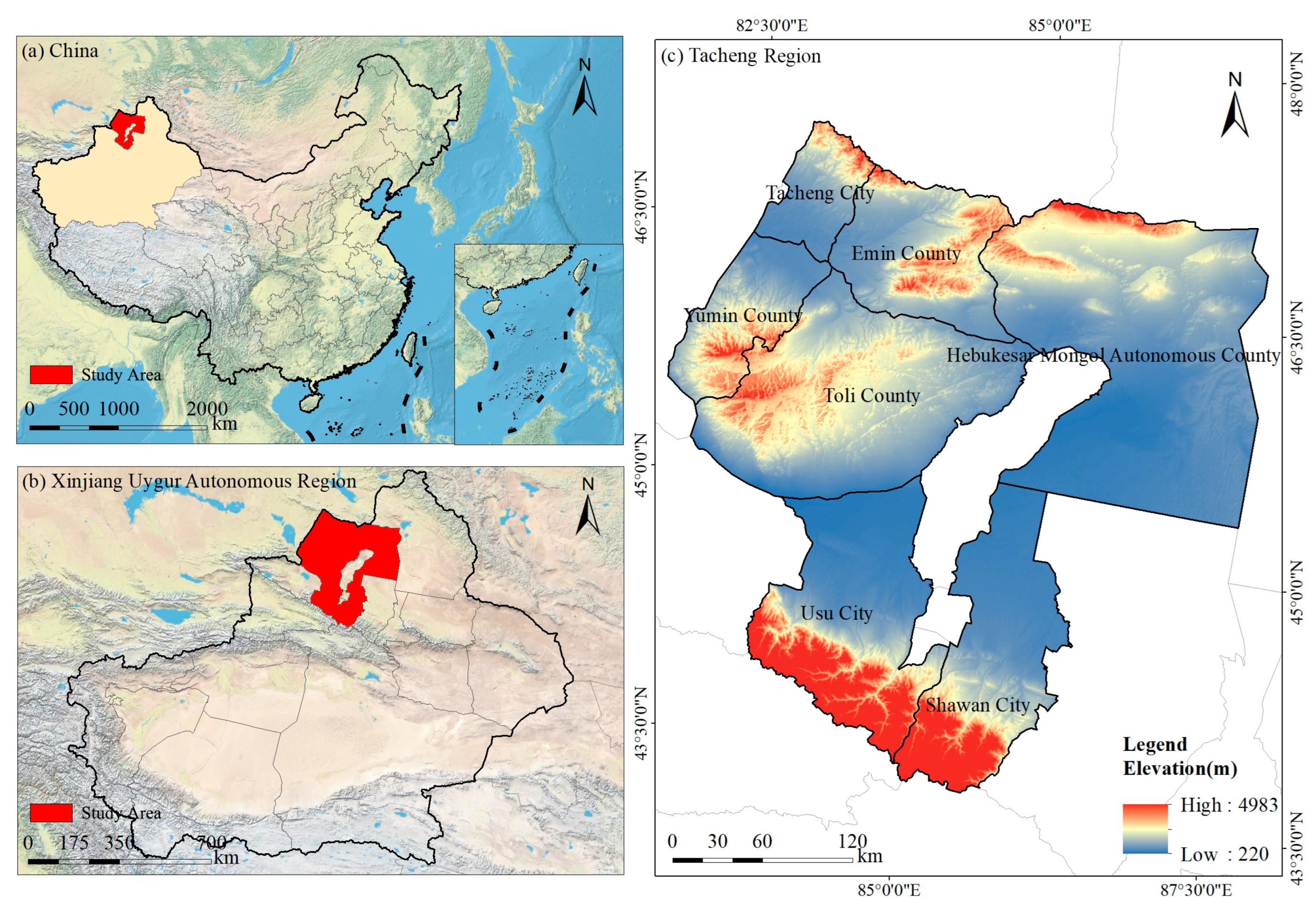
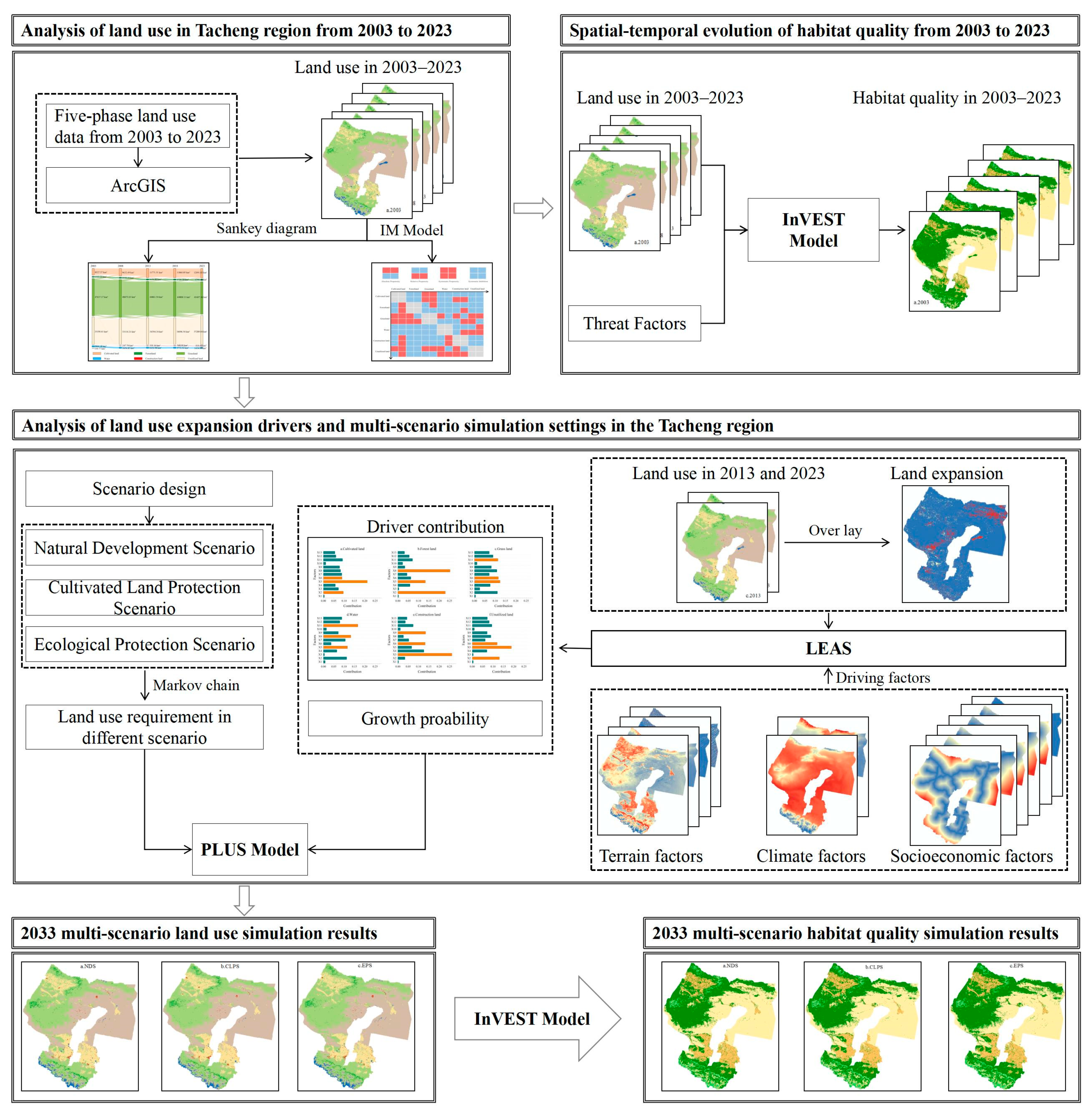
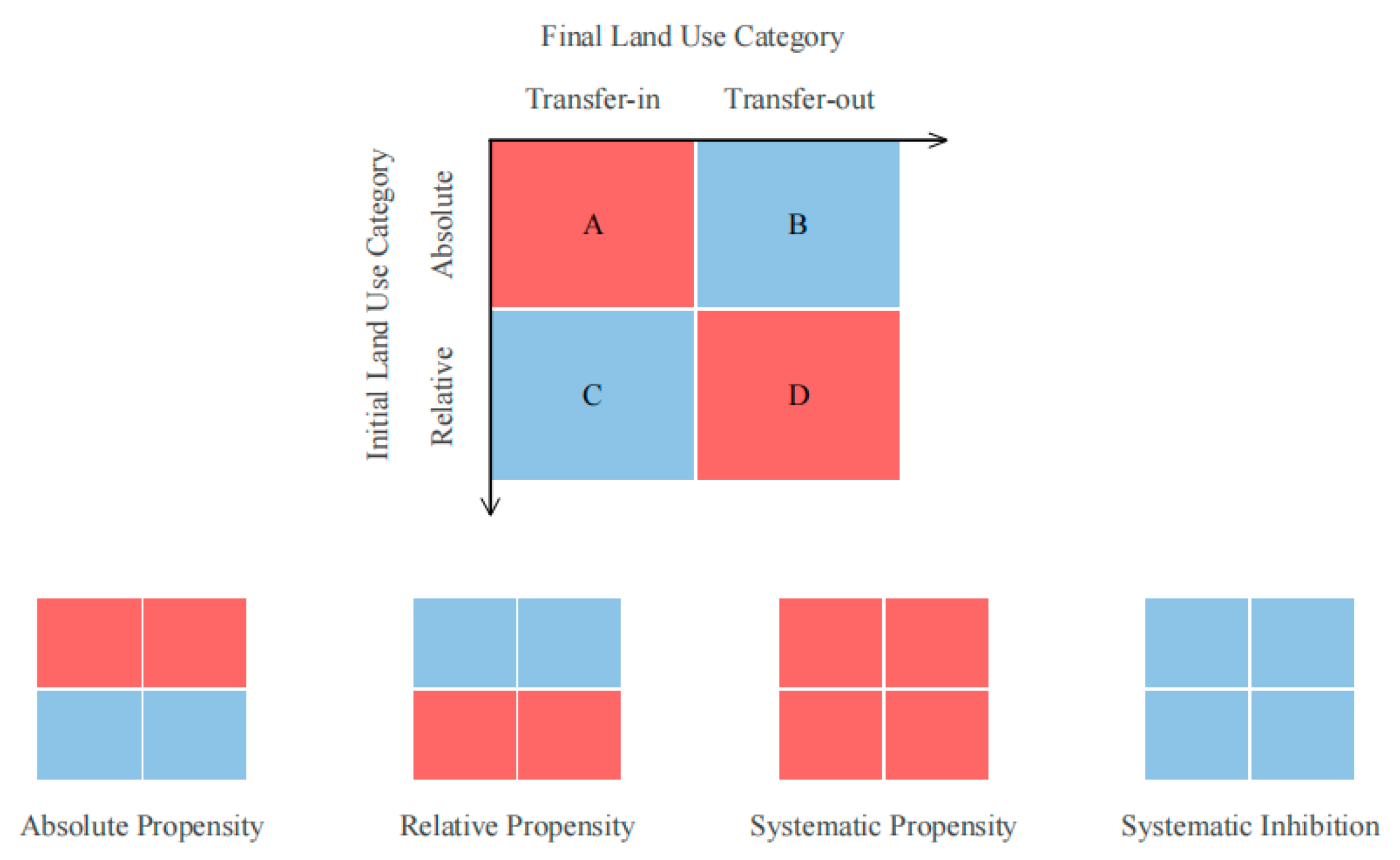
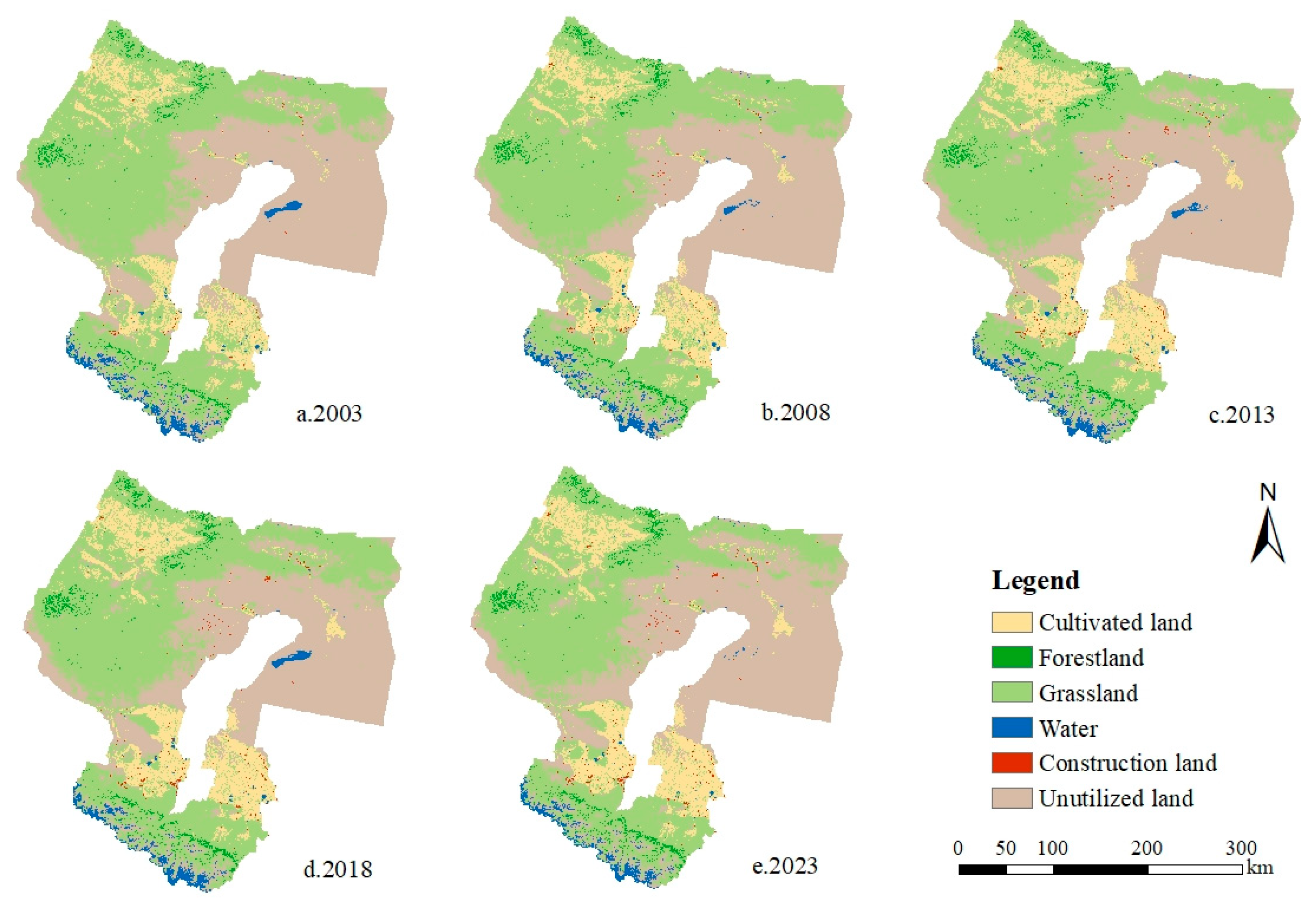
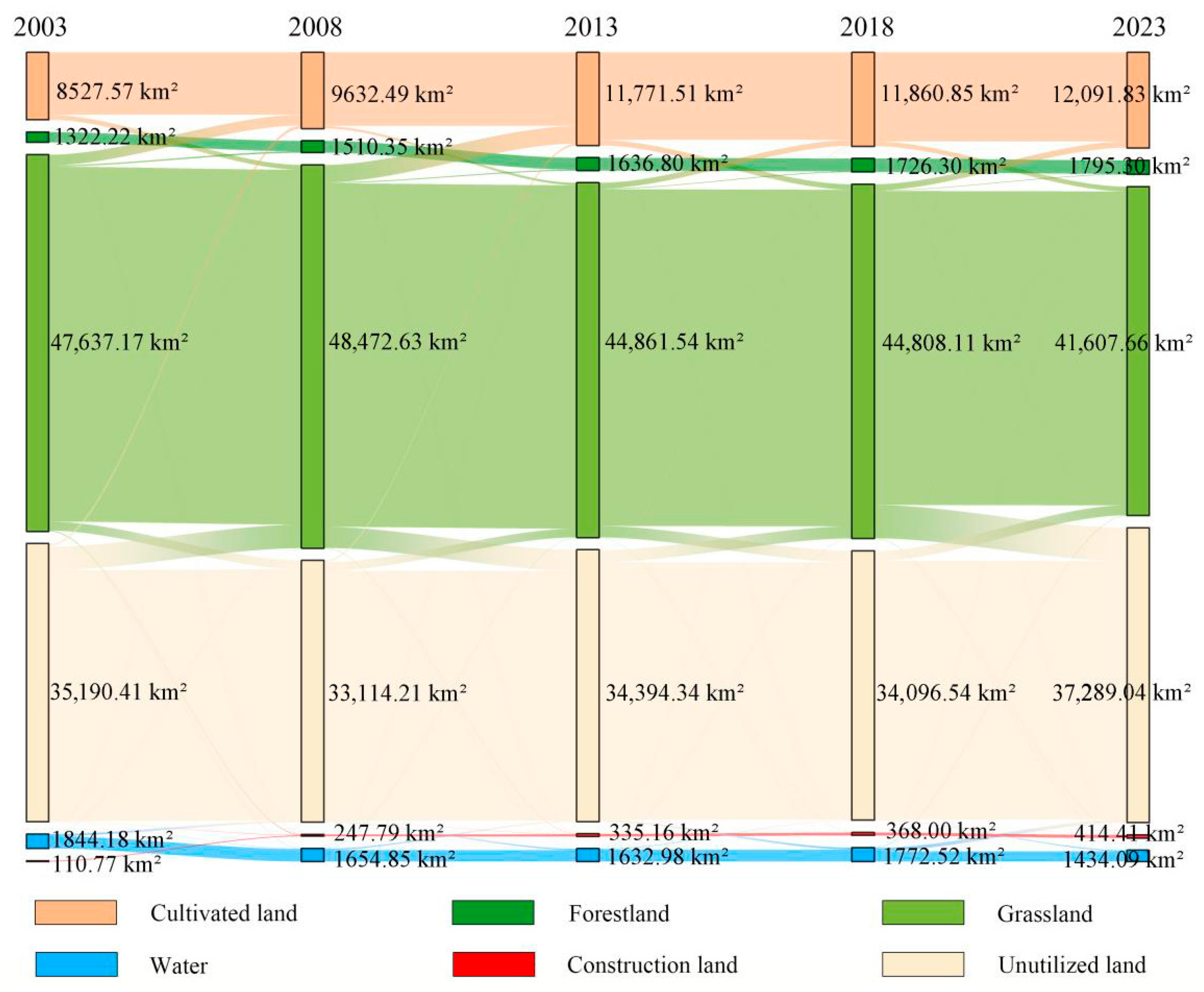
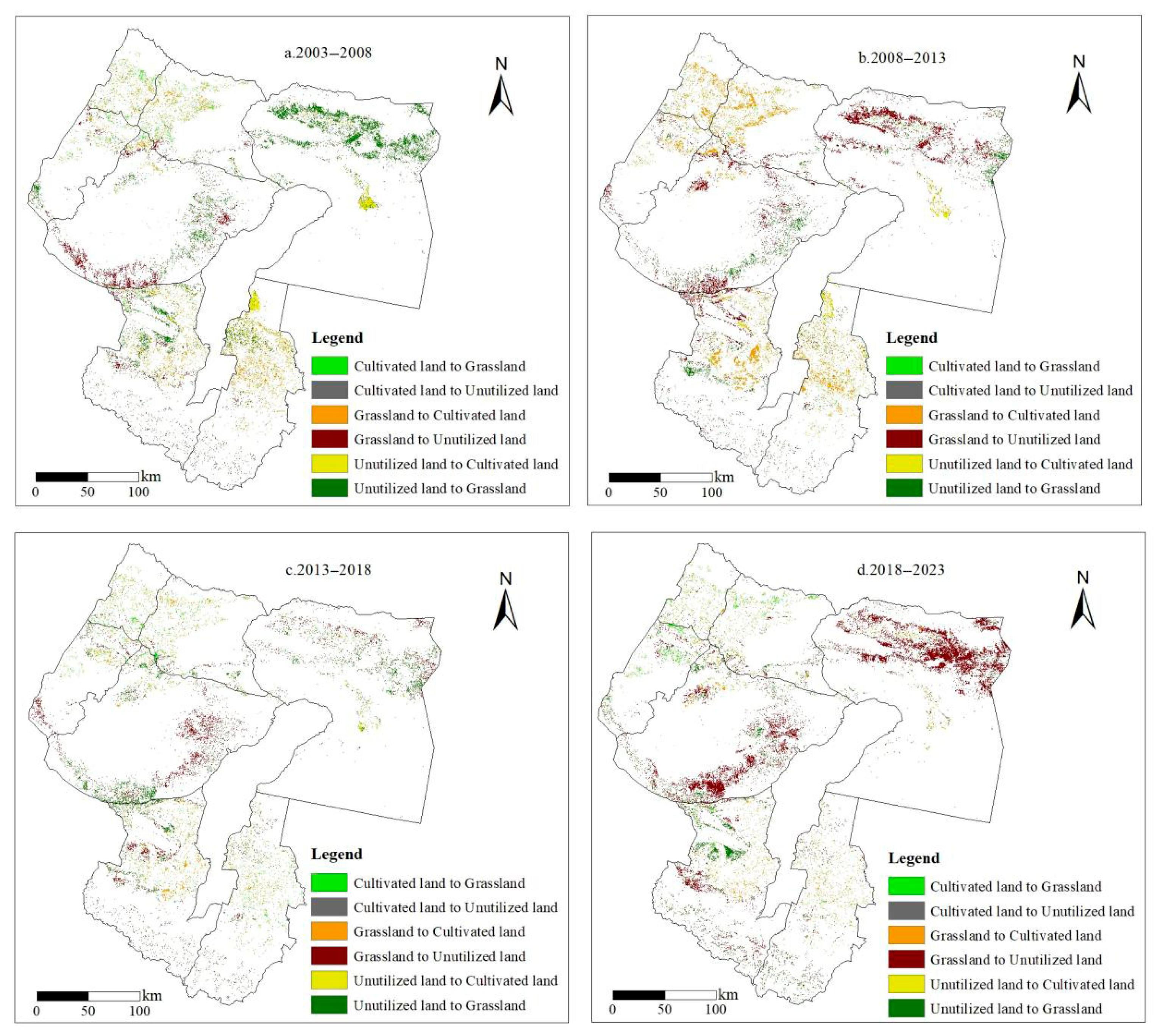
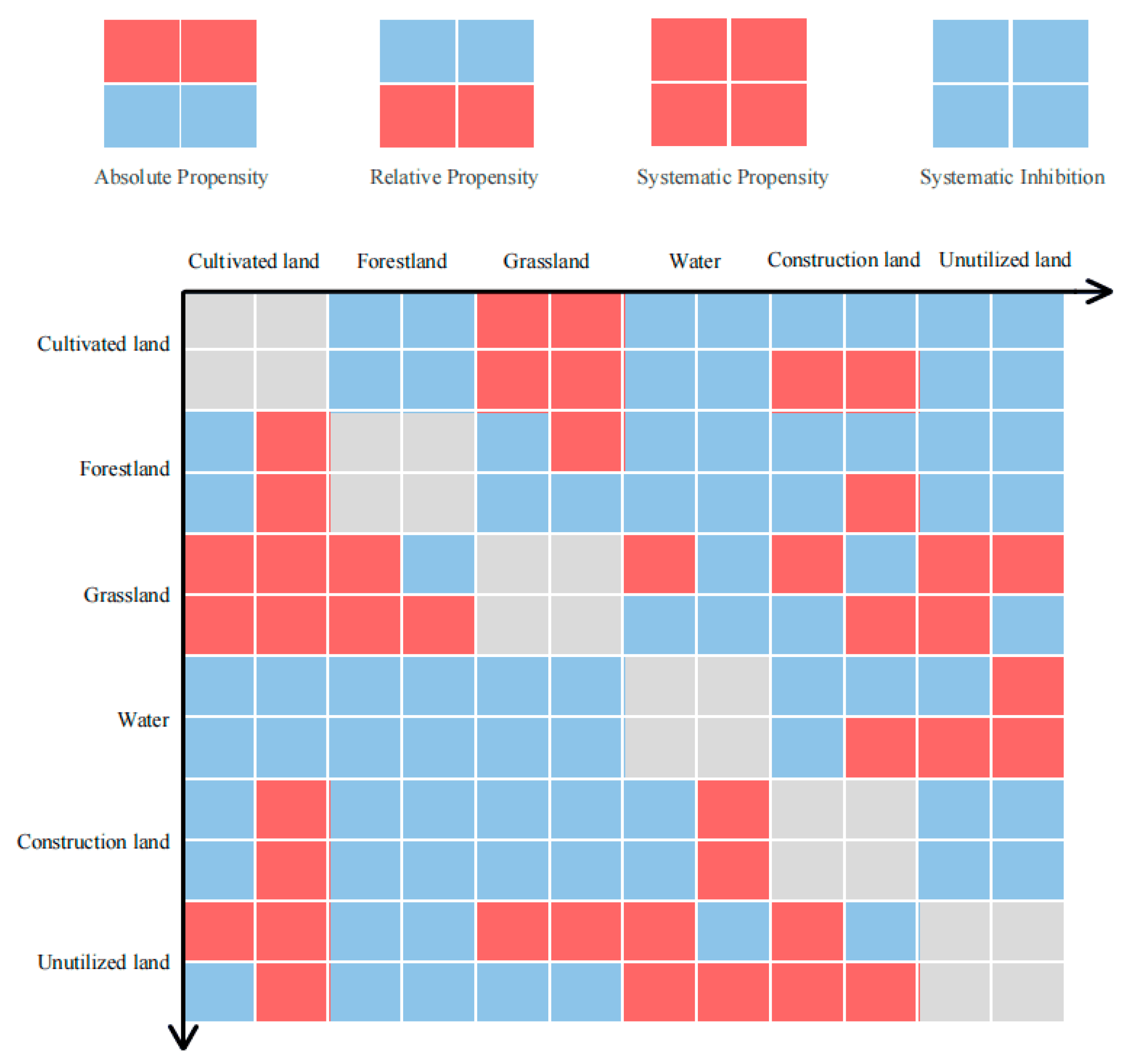

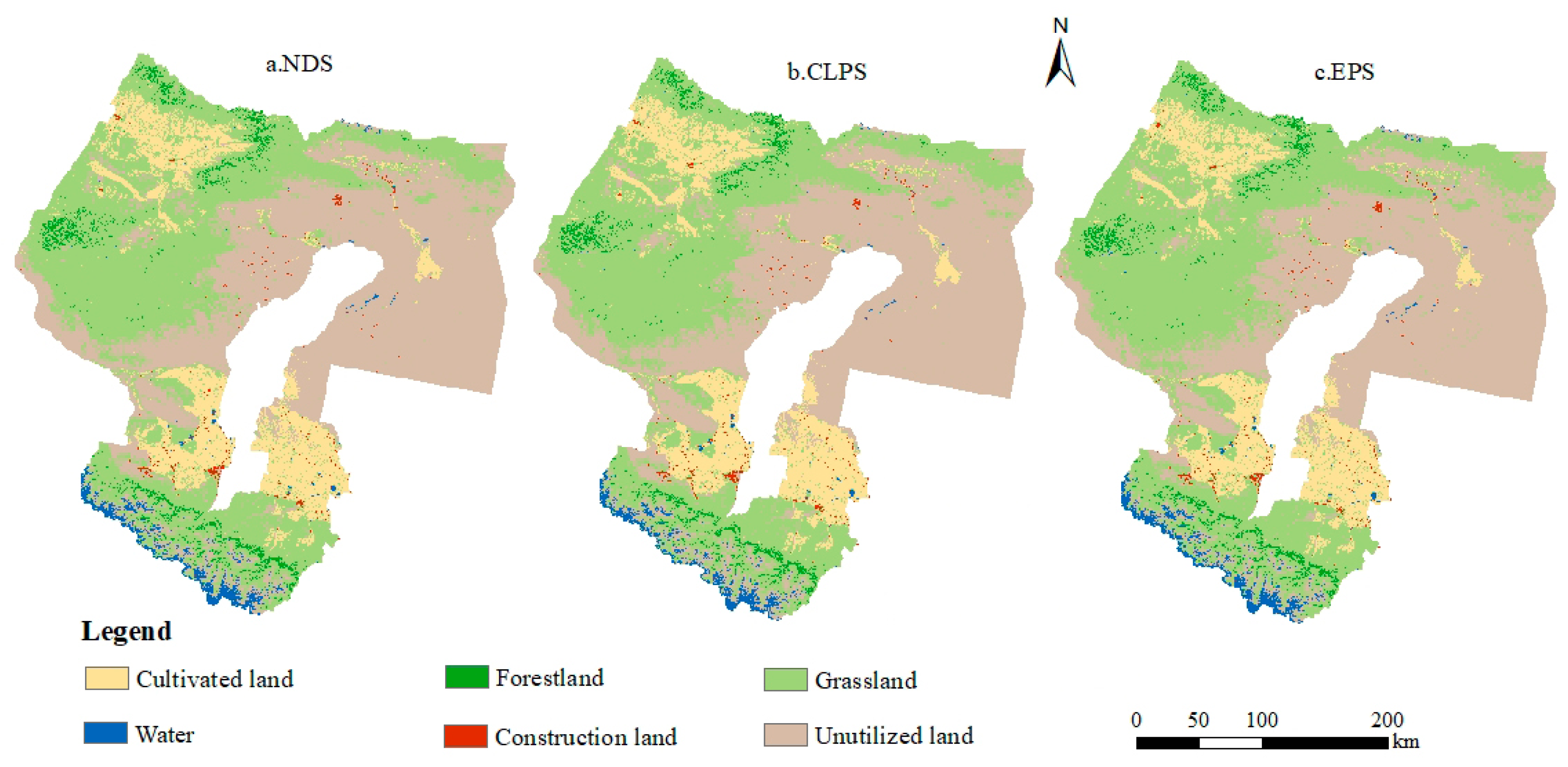
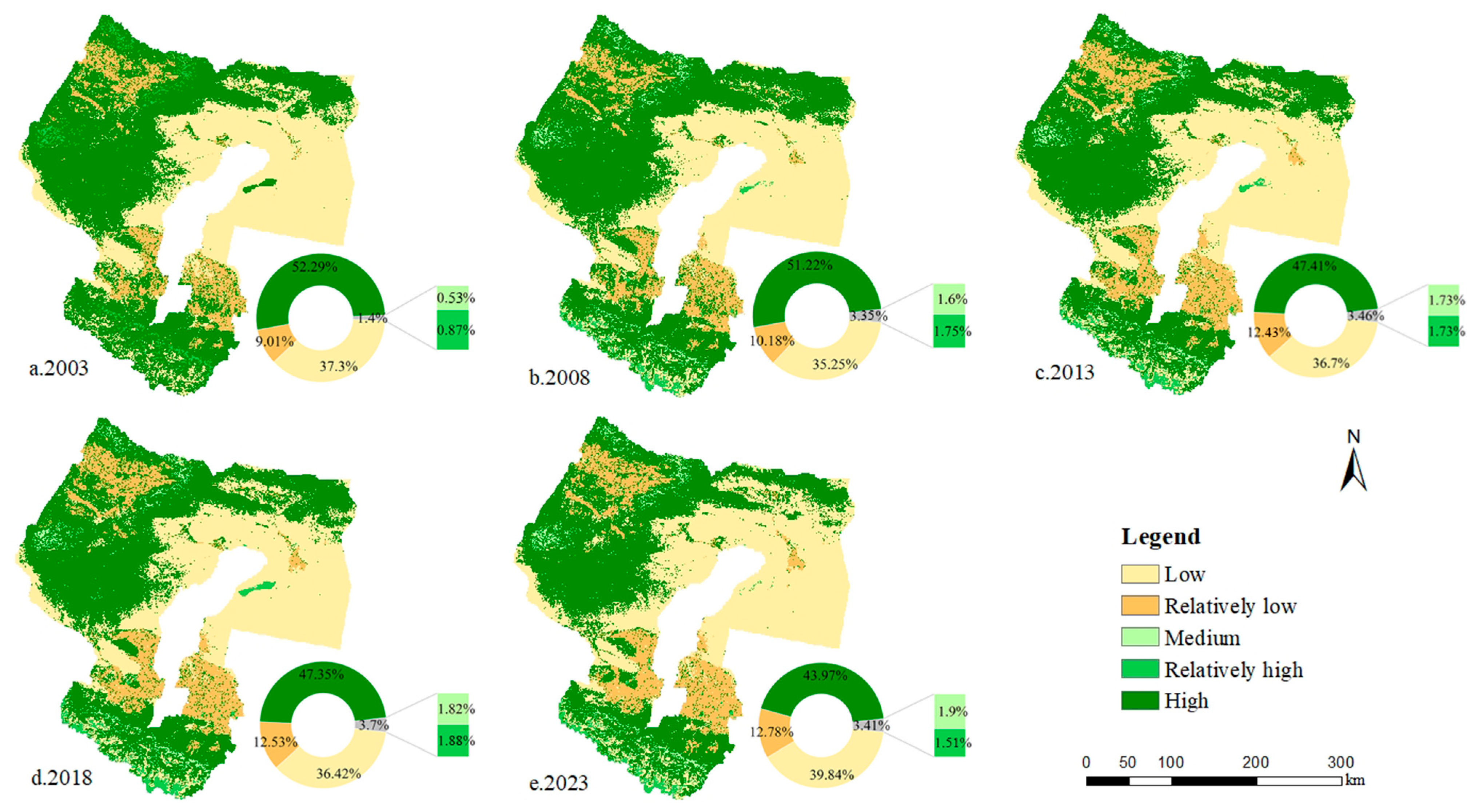
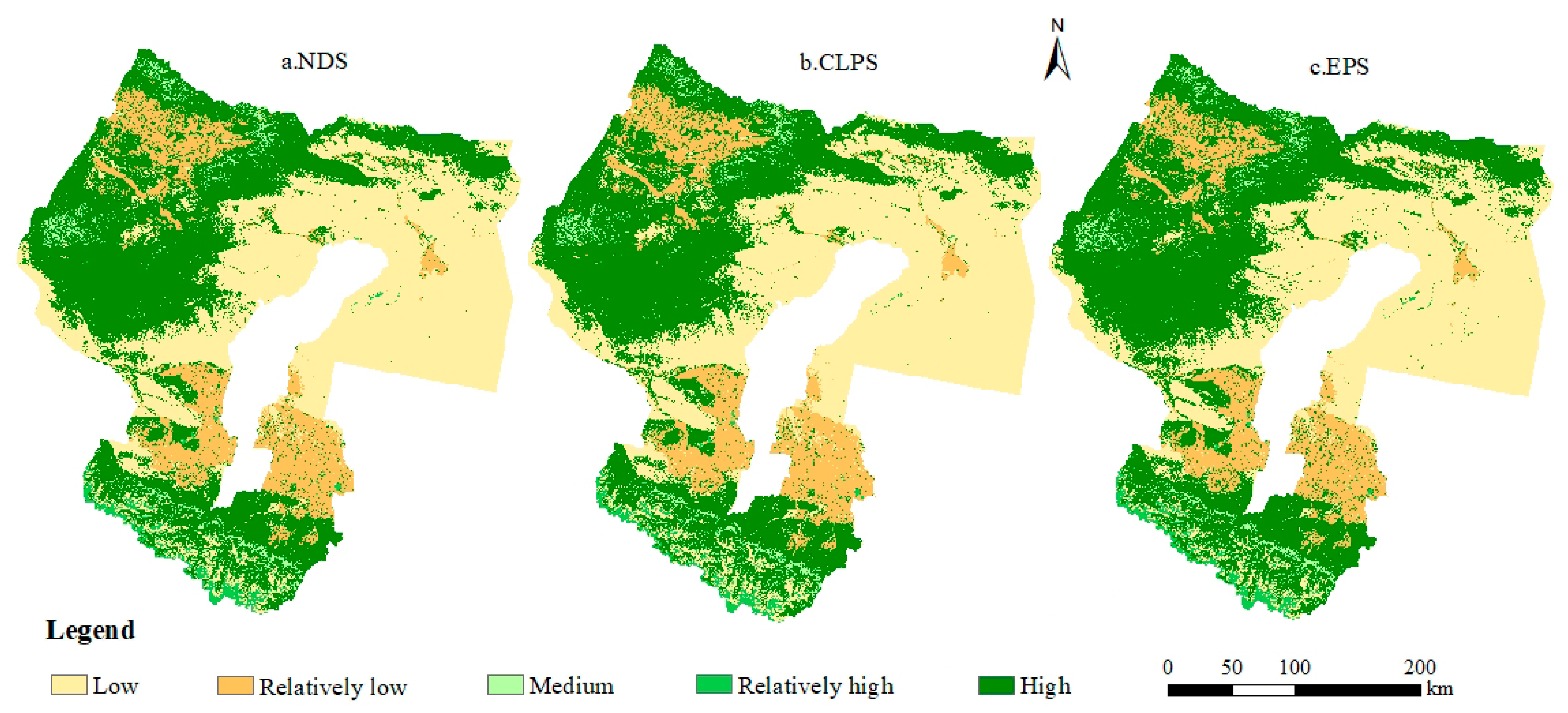
| Threat Factors | Maximum Distance (km) | Weight | Decay |
|---|---|---|---|
| Cultivated land | 6 | 0.6 | Linear |
| Construction land | 8 | 0.8 | Exponential |
| Unutilized land | 4 | 0.5 | Linear |
| Railway | 3 | 0.4 | Linear |
| Highway | 1 | 0.3 | Linear |
| Land Use Type | Habitat Suitability | Threat Factors | ||||
|---|---|---|---|---|---|---|
| Cultivated Land | Construction Land | Unutilized Land | Railway | Highway | ||
| Cultivated land | 0.5 | 0.2 | 0.8 | 0.5 | 0.4 | 0.6 |
| Forestland | 0.8 | 0.5 | 0.8 | 0.5 | 0.6 | 0.5 |
| Grassland | 1 | 0.4 | 0.6 | 0.3 | 0.7 | 0.6 |
| Water | 0.9 | 0.4 | 0.6 | 0.4 | 0.6 | 0.5 |
| Construction land | 0 | 0 | 0 | 0 | 0 | 0 |
| Unutilized land | 0.2 | 0.2 | 0.3 | 0 | 0 | 0 |
| Land Use Type | Cultivated Land | Forestland | Grassland | Water | Construction Land | Unutilized Land |
|---|---|---|---|---|---|---|
| Neighborhood weight | 0.375 | 0.285 | 0.216 | 0.182 | 0.683 | 0.236 |
| Land Use Type | NDS | CLPS | EPS | |||||||||||||||
|---|---|---|---|---|---|---|---|---|---|---|---|---|---|---|---|---|---|---|
| a | b | c | d | e | f | a | b | c | d | e | f | a | b | c | d | e | f | |
| a | 1 | 1 | 1 | 1 | 1 | 1 | 1 | 0 | 0 | 0 | 0 | 0 | 1 | 1 | 1 | 1 | 1 | 0 |
| b | 1 | 1 | 1 | 1 | 1 | 1 | 1 | 1 | 1 | 0 | 1 | 1 | 0 | 1 | 0 | 0 | 0 | 0 |
| c | 1 | 1 | 1 | 1 | 1 | 1 | 1 | 1 | 1 | 1 | 1 | 1 | 0 | 1 | 1 | 1 | 0 | 0 |
| d | 1 | 1 | 1 | 1 | 1 | 1 | 1 | 0 | 1 | 1 | 1 | 1 | 0 | 0 | 0 | 1 | 0 | 0 |
| e | 1 | 1 | 1 | 1 | 1 | 1 | 0 | 0 | 0 | 0 | 1 | 0 | 0 | 0 | 0 | 0 | 1 | 0 |
| f | 1 | 1 | 1 | 1 | 1 | 1 | 1 | 1 | 1 | 1 | 1 | 1 | 1 | 1 | 1 | 1 | 1 | 1 |
| Category | Years | Land Use Types | |||||
|---|---|---|---|---|---|---|---|
| Cultivated Land | Forestland | Grassland | Water | Construction Land | Unutilized Land | ||
| Area of Land Categories | 2003 | 8527.57 | 1322.22 | 47,637.17 | 1844.18 | 110.77 | 35,190.41 |
| 2008 | 9632.49 | 1510.35 | 48,472.63 | 1654.85 | 247.79 | 33,114.21 | |
| 2013 | 11,771.51 | 1636.80 | 44,861.54 | 1632.98 | 335.16 | 34,394.34 | |
| 2018 | 11,860.85 | 1726.30 | 44,808.11 | 1772.52 | 368.00 | 34,096.54 | |
| 2023 | 12,091.83 | 1795.30 | 41,607.66 | 1434.09 | 414.41 | 37,289.04 | |
| Land Category Area Changes | 2003–2008 | 1104.92 | 188.13 | 835.46 | −189.33 | 137.02 | −2076.20 |
| 2008–2013 | 2139.02 | 126.45 | −3611.10 | −21.87 | 87.37 | 1280.13 | |
| 2013–2018 | 89.34 | 89.50 | −53.42 | 139.54 | 32.84 | −297.80 | |
| 2018–2023 | 230.98 | 68.99 | −3200.45 | −338.44 | 46.41 | 3192.50 | |
| 2003–2023 | 3564.26 | 473.08 | −6029.51 | −410.10 | 303.64 | 2098.63 | |
| 2003 | 2023 | |||||||
|---|---|---|---|---|---|---|---|---|
| Cultivated Land | Forestland | Grassland | Water | Construction Land | Unutilized Land | Total | Transfer-Out | |
| Cultivated land | 7670.05 | 4.83 | 792.06 | 5.95 | 40.42 | 14.26 | 8527.57 | 857.52 |
| Forestland | 4.00 | 1316.77 | 1.29 | 0.02 | 0.14 | 0.00 | 1322.22 | 5.45 |
| Grassland | 3491.45 | 463.90 | 38,995.79 | 43.32 | 141.61 | 4501.10 | 47,637.17 | 8641.38 |
| Water | 13.54 | 9.16 | 88.84 | 1227.77 | 5.48 | 499.39 | 1844.18 | 616.41 |
| Construction land | 0.11 | 0.00 | 0.06 | 0.20 | 110.38 | 0.01 | 110.77 | 0.39 |
| Unutilized land | 912.68 | 0.63 | 1729.62 | 156.83 | 116.39 | 32,274.27 | 35,190.41 | 2916.14 |
| Total | 12,091.83 | 1795.30 | 41,607.66 | 1434.09 | 414.41 | 37,289.04 | ||
| Transfer-in | 4421.78 | 478.52 | 2611.87 | 206.31 | 304.04 | 5014.77 | ||
| Land Use Type | 2023 Area | NDS | CLPS | EPS | |||
|---|---|---|---|---|---|---|---|
| Area (km2) | Change Rate (%) | Area (km2) | Change Rate (%) | Area (km2) | Change Rate (%) | ||
| Cultivated land | 12,091.83 | 12,316.24 | 1.86% | 12,713.92 | 5.14% | 11,881.76 | −1.74% |
| Forestland | 1795.30 | 1941.27 | 8.13% | 1937.78 | 7.94% | 1938.75 | 7.99% |
| Grassland | 41,607.66 | 38,912.68 | −6.48% | 38,635.33 | −7.14% | 42,401.03 | 1.91% |
| Water | 1434.09 | 1295.72 | −9.65% | 1295.19 | −9.69% | 1527.09 | 6.49% |
| Construction land | 414.41 | 492.79 | 18.91% | 482.79 | 16.50% | 472.24 | 13.95% |
| Unutilized land | 37,289.04 | 39,673.64 | 6.39% | 39,567.31 | 6.11% | 36,411.46 | −2.35% |
| Habitat Quality | 2003 | 2008 | 2013 | 2018 | 2023 | |||||
|---|---|---|---|---|---|---|---|---|---|---|
| Area (km2) | Proportion (%) | Area (km2) | Proportion (%) | Area (km2) | Proportion (%) | Area (km2) | Proportion (%) | Area (km2) | Proportion (%) | |
| Low | 35,301.18 | 37.30 | 33,362.00 | 35.25 | 34,729.50 | 36.70 | 34,464.54 | 36.42 | 37,703.46 | 39.84 |
| Relatively low | 8527.57 | 9.01 | 9632.49 | 10.18 | 11,771.51 | 12.43 | 11,860.85 | 12.53 | 12,091.83 | 12.78 |
| Medium | 495.31 | 0.53 | 1510.35 | 1.60 | 1636.80 | 1.73 | 1726.30 | 1.82 | 1795.30 | 1.90 |
| Relatively high | 826.91 | 0.87 | 1654.85 | 1.75 | 1632.98 | 1.73 | 1772.52 | 1.88 | 1434.09 | 1.51 |
| High | 49,481.35 | 52.29 | 48,472.63 | 51.22 | 44,861.54 | 47.41 | 44,808.11 | 47.35 | 41,607.66 | 43.97 |
| Habitat Quality | 2023 | 2033 | ||||||
|---|---|---|---|---|---|---|---|---|
| NDS | CLPS | EPS | ||||||
| Area (km2) | Proportion(%) | Area (km2) | Proportion (%) | Area (km2) | Proportion (%) | Area (km2) | Proportion (%) | |
| Low | 37,703.46 | 39.84 | 39,973.09 | 42.24 | 40,050.10 | 42.32 | 36,883.71 | 38.98 |
| Relatively low | 12,091.83 | 12.78 | 12,316.24 | 13.01 | 12,713.92 | 13.44 | 11,881.76 | 12.56 |
| Medium | 1795.30 | 1.90 | 1941.27 | 2.05 | 1937.78 | 2.05 | 1938.75 | 2.05 |
| High | 1434.09 | 1.52 | 1489.06 | 1.57 | 1295.19 | 1.37 | 1527.09 | 1.61 |
| Relatively high | 41,607.66 | 43.97 | 38,912.68 | 41.12 | 38,635.33 | 40.83 | 42,401.03 | 44.81 |
Disclaimer/Publisher’s Note: The statements, opinions and data contained in all publications are solely those of the individual author(s) and contributor(s) and not of MDPI and/or the editor(s). MDPI and/or the editor(s) disclaim responsibility for any injury to people or property resulting from any ideas, methods, instructions or products referred to in the content. |
© 2025 by the authors. Licensee MDPI, Basel, Switzerland. This article is an open access article distributed under the terms and conditions of the Creative Commons Attribution (CC BY) license (https://creativecommons.org/licenses/by/4.0/).
Share and Cite
Zhang, Z.; Qi, S.; Abulizi, A.; Zhang, Y. Habitat Quality Evolution and Multi-Scenario Simulation Based on Land Use Change in the Tacheng Region. Sustainability 2025, 17, 6113. https://doi.org/10.3390/su17136113
Zhang Z, Qi S, Abulizi A, Zhang Y. Habitat Quality Evolution and Multi-Scenario Simulation Based on Land Use Change in the Tacheng Region. Sustainability. 2025; 17(13):6113. https://doi.org/10.3390/su17136113
Chicago/Turabian StyleZhang, Zhenyu, Shuangshang Qi, Abudukeyimu Abulizi, and Yongfu Zhang. 2025. "Habitat Quality Evolution and Multi-Scenario Simulation Based on Land Use Change in the Tacheng Region" Sustainability 17, no. 13: 6113. https://doi.org/10.3390/su17136113
APA StyleZhang, Z., Qi, S., Abulizi, A., & Zhang, Y. (2025). Habitat Quality Evolution and Multi-Scenario Simulation Based on Land Use Change in the Tacheng Region. Sustainability, 17(13), 6113. https://doi.org/10.3390/su17136113





